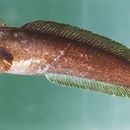Brief Summary
provided by Ecomare
Five-bearded rocklings have five barbels on their head, one on the chin and four on the snout. Although these fish look slippery, they do have scales which are very small and delicate. Five-bearded rocklings are predator fish. They hunt mostly shrimp, as well as small fish. In turn, young rocklings are often consumed by gulls and terns. There are more species of rocklings living in the North Sea, including the three and four-bearded rockling. But the five-bearded rockling is the most common and not surprisingly referred to as the common rockling.
- license
- cc-by-nc
- copyright
- Copyright Ecomare
Diagnostic Description
provided by Fishbase
Head relatively small, more than five times in SL. No lobed fold of skin above the upper lip. First fin ray followed by a row of small, fleshy filaments. Dark brown dorsally, reddish to blackish grading to pale gray-brown ventrally (Ref. 1371). One barbel on the lower jaw and four on the snout (Ref. 35388).
Life Cycle
provided by Fishbase
Eggs and larvae are pelagic.
Migration
provided by Fishbase
Oceanodromous. Migrating within oceans typically between spawning and different feeding areas, as tunas do. Migrations should be cyclical and predictable and cover more than 100 km.
Morphology
provided by Fishbase
Dorsal spines (total): 0; Analspines: 0
Biology
provided by Fishbase
A resident intertidal species with homing behavior (Ref. 32612). Generally close to the shore, not descending to great depths beyond the limits of the distribution of green algae (20 m), preferring rock bottoms but also living on sandy, muddy, and shell gravel bottoms. Feed mainly on crustaceans, sometimes also on algae, polychaetes, gastropods and occasionally, small fish. Occurs in temperatures ranging from 8 to 24°C (Ref. 4944).
Importance
provided by Fishbase
fisheries: commercial
Fivebeard rockling
provided by wikipedia EN
The fivebeard rockling (Ciliata mustela) is a coastal ray-finned fish of the family Lotidae. the lings and rocklings. It is found in the eastern Atlantic Ocean. It is not a fish of any commercial importance.
Description
The fivebeard rocklings is a long, slender fish which may attain a length of 25 centimetres (9.8 in). It has a smooth, scaleless body with unusual and long dorsal, which is made up of a first ray followed by a line of vibrating rays in a furrow in the back. The front part of the dorsal fin does not have any membrane connecting the rays although the rear dorsal fin is which runs the length of the body, as does the anal fin, is made up of rays connected by membrane.[3] It has five barbels around its mouth, two above either nostril and a single barbel on the lower jaw. It has a rather small mouth with the corners of the mouth just going beyond the eye. The main colour is dark brown.[4] This fades to pale gray-brown on the underside.[2]
Distribution
The fivebeard rockling is found in the eastern Atlantic from Finnmark to Lisbon, including the Skagerrak, the Kattegat, Iceland and around Great Britain and Ireland.[2]
Habitat and biology
The fivebeard rockling is found in the intertidal zone, often under rocks. They are usually found in rocky areas but it can be found in breakwater pools on sandy shores so long as these have a growth of algae.[4] These fish can display homing behaviour and are normally found no deeper than the lower limit for the growth of green algae, around 20 metres (66 ft). They are predatory fish and the major part of their diet is crustaceans but they will eat polychaetes, gastropods and small fish, they have also been recorded consuming algae. The five-bearded rockling has a temperature range of 8 to 24 °C (46 to 75 °F) Both sexes reach maturity at around one year old. A smaller female may lay as few as 9,000 eggs when spawning, while the largest females may lay as many as 30,000. Spawning takes place in the deeper waters of the Atlantic to the west of Ireland during February to May. The eggs and larvae are pelagic.[1]
Threats
The fivebeard rockling is regarded as being of least concern by the IUCN and is not a commercially important species, in the warmer waters in which it occurs it may be threatened by climate change.[1]
References
-
^ a b c Fernandes, P.; Cook, R.; Florin, A.; Lorance, P.; Nielsen, J.; Nedreaas, K. (2014). "Ciliata mustela". IUCN Red List of Threatened Species. 2014: e.T18125362A45129775. doi:10.2305/IUCN.UK.2014-3.RLTS.T18125362A45129775.en. Retrieved 19 November 2021.
-
^ a b c Froese, Rainer; Pauly, Daniel (eds.) (2019). "Ciliata mustela" in FishBase. December 2019 version.
-
^ "Five-Bearded Rockling". British Marine Life Study Society. Retrieved 16 March 2020.
-
^ a b Barnes, M.K.S. (2008). Tyler-Walters H.; Hiscock K. (eds.). "Ciliata mustela Five-bearded rockling". Marine Life Information Network: Biology and Sensitivity Key Information Reviews, [on-line]. Plymouth. Marine Biological Association of the United Kingdom. Retrieved 16 March 2020.

- license
- cc-by-sa-3.0
- copyright
- Wikipedia authors and editors
Fivebeard rockling: Brief Summary
provided by wikipedia EN
The fivebeard rockling (Ciliata mustela) is a coastal ray-finned fish of the family Lotidae. the lings and rocklings. It is found in the eastern Atlantic Ocean. It is not a fish of any commercial importance.
- license
- cc-by-sa-3.0
- copyright
- Wikipedia authors and editors

